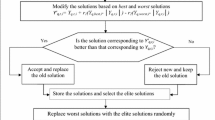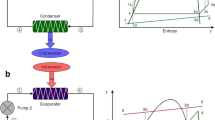Abstract
This study proposes a brand new practical multi-agent optimization framework based on an intelligent collaborative interaction between some prevalent metaheuristic algorithms available in the literature. Proposed optimization architecture is built on widely known and reputed master–slave model assisted with some useful and promising modifications. Conventional stochastic-based optimization algorithms including Particle Swarm Optimization, Crow Search Algorithm, Differential Evolution, and Global Best Algorithm are structurally coordinated to form the slave populations, while the best solutions obtained from these slave subpopulations are forming the master individuals. Contrary to the traditional master–slave approach, master individuals in this proposed framework becomes more functional by performing an extensive local search over numerical results of the best slave individuals. Main aim in constructing such a highly devised multi-agent algorithm is to maintain an effective communication domain between slave individuals (agents) as well as to enhance the capabilities of the cooperative search mechanism through the systematic combination of metaheuristics. Optimization performance of the proposed framework is tested on a suite of 29 optimization benchmark functions. Proposed optimization method surpasses the compared optimization algorithms in 27 out of 29 problems and proves its solution efficiency in multidimensional optimization problems. Then, proposed strategy is applied on single and multi-objective thermal design of a shell and tube evaporator operated with \(\hbox {R134a/Al}_{2}\hbox {O}_{3}\) nanorefrigerant. It is seen that maximum overall heat transfer coefficient is increased by 18.1% and minimum total cost of heat exchanger is reduced by 5.1% in the case of incorporating \(\hbox {Al}_{2}\hbox {O}_{3}\) nanoparticles into R134a.
Similar content being viewed by others
Abbreviations
- \(A_\mathrm{s}\) :
-
Heat exchange area (\(\hbox {m}^{2}\))
- \(a_\mathrm{s}\) :
-
Cross-sectional area normal to flow (\(\hbox {m}^{2}\))
- B :
-
Baffle spacing (m)
- \(C_\mathrm{p}\) :
-
Specific heat (kJ/kgK)
- \(C_\mathrm{e}\) :
-
Energy cost (€/kWh)
- \(C_\mathrm{l}\) :
-
Shell side clearance (m)
- \(C_\mathrm{i}\) :
-
Capital investment cost (€)
- \(C_\mathrm{np}\) :
-
Cost of nanoparticle (€)
- \(C_\mathrm{o}\) :
-
Annual operation cost (€/year)
- \(C_\mathrm{od}\) :
-
Total operating cost (€)
- D :
-
Problem dimension
- \(D_\mathrm{e}\) :
-
Hydraulic shell diameter (m)
- \(D_\mathrm{s}\) :
-
Shell inside diameter (m)
- d :
-
Tube diameter (m)
- \(d_\mathrm{p}\) :
-
Nanoparticle diameter (m)
- \(f_\mathrm{s}\) :
-
Shell side friction factor
- F :
-
Correction factor
- \(F_\mathrm{PD}\) :
-
Nanoparticle enhancement factor
- G :
-
Mass velocity (\(\hbox {kg/m}^{2}\hbox {s}\))
- H :
-
Annual operating time (h/year)
- h :
-
Heat transfer coefficient (\(\hbox {W/m}^{2}\hbox {K}\))
- i :
-
Annual discount rate (%)
- k :
-
Heat conductivity (W/mK)
- L :
-
Tube length (m)
- \(\dot{m}\) :
-
Mass flow rate (kg/s)
- N :
-
Population size
- ny:
-
Equipment life (year)
- \(N_\mathrm{p}\) :
-
Number of tube pass
- \(N_\mathrm{t}\) :
-
Total number of tubes
- P :
-
Pumping power (W)
- Pr :
-
Prandtl number
- \(P_\mathrm{t}\) :
-
Tube pitch (m)
- \(\Delta P\) :
-
Pressure drop (Pa)
- Re :
-
Reynolds number
- Q :
-
Imposed heat load (W)
- \(R_\mathrm{f}\) :
-
Fouling resistance (\(\hbox {m}^{2}\hbox {K/W}\))
- T :
-
Temperature (\(\hbox {K-}^{\circ }\hbox {C}\))
- \(\Delta T_\mathrm{LMTD}\) :
-
Logarithmic mean temperature difference
- v :
-
Working fluid velocity (m/s)
- x :
-
Vapour quality
- U :
-
Overall heat transfer coefficient (\(\hbox {W/m}^{2}\hbox {K}\))
- \(\mu \) :
-
Dynamic viscosity (Pa s)
- \(\rho \) :
-
Density (\(\hbox {kg/m}^{3}\))
- \(\eta \) :
-
Pumping efficiency
- \(\phi \) :
-
Nanoparticle volume concentration (%), Chaotic random number
- i:
-
Inlet
- L:
-
Liquid
- n:
-
Nanoparticle
- o:
-
Outlet
- r:
-
Refrigerant
- s:
-
Shell side
- t:
-
Tube side
- TP:
-
Two phase
- w:
-
Wall
References
Neapolitan, R.; Naimipour, K.: Foundations of Algorithms Using C++ Pseudo Code. Jones Barlett Publishers, Burlington (2004)
Wolpert, D.; Macready, W.: No free lunch theorems for optimization. IEEE Trans. Evol. Comput. 1, 67–82 (1997)
Verma, A.K.; Sirvaiya, A.: Intelligent prediction of Langmuir isotherms of Gondwana coals in India. J. Pet. Explor. Prod. Technol. 6, 135–143 (2016)
Singh, T.N.; Kanchan, R.; Salga, K.; Verma, A.K.: Prediction of p-wave velocity and anisotropic property of rock using artificial neural network technique. J. Sci. Ind. Res. 63, 32–33 (2004)
Singh, T.N.; Verma, A.K.; Singh, V.; Sahu, A.: Slake durability study of shaly rock and its predictions. Environ. Geol. 47(2), 256–253 (2005)
Cholette, M.E.; Borghesani, P.; Gialleonardo, E.D.; Braghin, B.: Using support vector machines for the computationally efficient identification of the acceptable design parameters in computer-aided engineering applications. Expert Syst. Appl. 81, 39–52 (2017)
Riessen, B.; Negenborn, R.R.; Dekker, R.: Real-time contained transport planning with decision trees based on offline obtained optimal solutions. Decis. Support Syst. 89, 1–16 (2016)
Andrejiova, M.; Grincova, A.; Marasova, D.: Failure analysis of rubber composites under dynamic impact loading by logistic regression. Eng. Fail. Anal. 84, 311–319 (2018)
Ikeda, S.; Ooka, R.: Metaheuristic optimization methods for a comprehensive operating schedule of battery, thermal energy storage, and heat source in a building energy systems. Appl. Energy 151, 192–205 (2015)
Cavazzini, G.; Bari, S.; Pavesi, G.; Ardizzon, G.: A multi-fluid PSO-based algorithm for the search of the best performance of sub-critical Organic Rankine Cycles. Energy 129, 42–58 (2017)
Boyaghchi, F.A.; Heidarnejad, P.: Thermoeconomic assessment and multi objective optimization of a solar micro CCHP based on Organic Rankine Cycle for domestic application. Energy Convers. Manag. 97, 224–234 (2015)
Ponce-Ortega, J.M.; Serna-Gonzalez, M.; Jimenez Gutierrez, A.: Use of genetic algorithms for optimal design of shell-and-tube heat exchangers. Appl. Therm. Eng. 29, 203–209 (2009)
Patel, V.K.; Rao, R.V.: Design optimization of shell and tube heat exchanger using particle swarm optimization technique. Appl. Therm. Eng. 30, 1417–1425 (2010)
Sahin, A.S.; Kilic, B.; Kilic, U.: Design and economic optimization of shell and tube heat exchangers using Artificial Bee Colony (ABC) algorithm. Energy Convers. Manag. 52, 3356–3362 (2011)
Hadidi, A.; Nazari, A.: Design and economic optimization of shell and tube heat exchangers using biogeography-based (BBO) algorithm. Appl. Therm. Eng. 51, 1263–1272 (2013)
Jaradat, G.; Ayob, M.; Almarashdeh, I.: The effect of elite pool in hybrid population-based meta-heuristic for solving combinatorial optimization problems. Appl. Soft Comput. 44, 45–56 (2016)
Gherbi, Y.A.; Bouzeboudja, H.; Gherbi, F.Z.: The combined economic environmental dispatch using new hybrid metaheuristic. Energy 115, 468–477 (2016)
Mohebbi, S.; Shafaei, R.: E-supply network coordination: the design of intelligent agents for buyer–supplier dynamic negotitations. J. Intell. Manuf. 23, 375–391 (2012)
Ayhan, M.B.; Aydin, M.E.; Oztemel, E.: A multi-agent based approach for change management in manufacturing enterprises. J. Intell. Manuf. 26, 975–988 (2015)
Kennedy, J.; Eberhart, R.: Particle Swarm Optimization. In: Proceedings of IEEE International Conference on Neural Networks, Vol. 4, pp. 1942–1948 (1994)
Storn, R.; Price, K.: Differential evolution—a simple and efficient heuristic for global optimization over continuous spaces. J. Global Optim. 11, 341–359 (1997)
Askarzadeh, A.: A novel metaheuristic method for solving constrained engineering optimization problems: crow search algorithm. Comput. Struct. 169, 1–12 (2016)
Turgut, O.E.; Coban, M.T.: Thermal design of spiral heat exchangers and heat pipes through global best algorithm. Heat Mass Transf. 53, 899–916 (2017)
Kern, D.Q.: Process Heat Transfer. Mc Graw-Hill, New York (1950)
Shah, M.M.: A new correlation for heat transfer during boiling flow through pipes. ASHRAE Trans. 82, 66–86 (1976)
Peng, H.; Ding, G.; Jiang, W.; Hu, H.; Gao, Y.: Heat transfer characteristics of refrigerant-based nanofluid flow boiling inside a horizontal smooth tube. Int. J. Refrig. 32, 1259–1270 (2009)
Peng, H.; Ding, G.; Jiang, W.; Hu, H.; Gao, Y.: Measurement and correlation of frictional pressure drop of refrigerant based nanofluid flow boiling inside a horizontal smooth tube. Int. J. Refrig. 32, 1756–1764 (2009)
Müller-Steinhagen, H.; Heck, K.: A simple friction pressure drop correlation for two-phase flow in pipes. Chem. Eng. Process. 20, 297–308 (1986)
Peters, M.S.; Timmerhaues, K.D.: Plant Design and Economics for Chemical Engineers. McGraw-Hill, New York (1991)
Caputo, A.C.; Pelagagge, P.M.; Salini, P.: Heat exchanger design based on economic optimization. Appl. Therm. Eng. 28, 1151–1159 (2008)
Taal, M.; Bulatov, I.; Klemes, P.; Stehlik, P.: Cost estimation and energy price forecast for economic evaluation of retrofit project. Appl. Therm. Eng. 23, 1819–1835 (2003)
Mariani, V.C.; Duck, A.R.K.; Guerra, F.A.; Coelho, LdS; Rao, R.V.: A chaotic quantum behaved particle swarm approach applied to optimization of heat exchangers. Appl. Therm. Eng. 42, 119–128 (2012)
Meignan, D.; Creput, J.; Koukam, A.: A coalition-based metaheuristic for the vehicle routing problem. In: Proceeding of IEEE Congress on Evolutionary Computation, CEC 2008, pp. 1176–1182 (2008)
Meignan, D.; Koukam, A.; Creput, J.C.: Coalition-based metaheuristic: a self-adaptive metaheuristic using reinforcement learning and mimetism. J. Heuristics 16, 859–879 (2010)
Milano, M.; Roli, A.: MAGMA: a multiagent architecture for metaheuristics. IEEE Trans. Syst. Man Cybern. B Cybern. 34, 925–941 (2004)
Aydin, M.E.: Metaheuristic agent teams for job shop scheduling problems. LNAI 4659, 185–194 (2007)
Crainic, T.; Toulouse, M.: Parallel strategies for meta-heuristics. In: State-of-the-Art Handbook in Metaheuristics, Kluwer, Dordrecht, pp. 475–513 (2003)
Talbi, E.G.; Bachelet, V.: Cosearch: a parallel cooperative metaheuristic. JMMA 5, 5–22 (2006)
Aydin, M.E.; Fogarty, T.C.: Teams of autonomous agents for job-scheduling problems: an experimental study. J. Intell. Manuf. 15, 455–462 (2004)
Jedrzejowicz, P.; Wierzbowska, I.: Jade-based a-team environment. In: 6th International Conference on Computational Science, pp. 28–31 (2006)
Civicioglu, P.: Transforming geocentric cartesian coordinates to geodetic coordinates by using differential search algorithm. Comput. Geosci. 46, 229–247 (2012)
May, R.M.: Simple mathematical models with very complicated dynamics. Nature 261, 459–467 (1976)
Opitz, D.; Maclin, R.: Popular ensemble methods: an empirical study. J. Artif. Intell. Res. 11, 169–198 (1999)
Yen, G.G.; Daneshyari, M.: Diversity-based information exchange among multiple swarms in particle swarm optimization. Int. J. Comput. Intell. Appl. 7, 57–75 (2008)
Zhan, Z.; Zhang, J.: Parallel particle swarm optimization with adaptive asynchronous migration strategy. In: Hua, A., Chag, S.L. (eds.) Algorithms and Architectures for Parallel Processing, Lecture Notes in Computer Science, vol. 5574, pp. 490–501. Springer, Berlin (2009)
Akbari, R.; Ziarati, K.A.: A cooperative approach to bee swarm optimization. JISE 27, 799–818 (2011)
Guo, Y.-N.; Liu, D.; Cheng, D.: Multi population cooperative cultural algorithms. In: Huang, D.S., Gan, Y., Premaratne, P., Han, K. (eds.) Bio-inspired Computing And Applications, Lecture Notes in Computer Science, vol. 6840, pp. 199–206. Springer, Berlin (2012)
Jaddi, N.S.; Abdullah, S.; Hamdan, A.R.: Multi-population cooperative bat algorithm based optimization of artificial neural network model. Inf. Sci. 294, 628–644 (2015)
Civicioglu, P.: Backtracking search optimization algorithm for numerical optimization problems. Appl. Math. Comput. 219, 8121–8144 (2013)
Yadav, P.; Kumar, R.; Panda, S.K.; Chang, C.S.: An intelligent tuned harmony search algorithm for optimization. Inf. Sci. 196, 47–72 (2012)
Yang, X.S.: A new metaheuristic bat-algorithm. In: Nature Inspired Cooperative Strategies for Optimization (NISCO 2010), Studies in Computational Intelligence, Vol. 284, pp. 65–74 (2010)
Sun, J.; Feng, B.; Xu, W.: Particle swarm optimization with particles having quantum behaviour. In: Proceedings of Congress on Evolutionary Computation, pp. 325–331 (2004)
Erol, O.K.; Eksin, I.: A new optimization method: big bang–big crunch. Adv. Eng. Softw. 37, 106–111 (2006)
Mirjalili, S.: Moth-flame optimization algorithm: a novel nature-inspired heuristic paradigm. Knowl. Based Syst. 89, 228–249 (2015)
Askarzadeh, A.: Bird mating optimizer: an optimization algorithm inspired by bird mating strategies. Commun. Nonlinear Sci. 19, 1213–1228 (2014)
Mirjalili, S.; Mirjalili, S.M.; Hatamlou, A.: Multi-verse optimizer: a nature-inspired algorithm for global optimization. Neural Comput. Appl. 27, 495–513 (2015)
Ahmadi, M.H.; Ahmadi, M.A.; Mohammadi, A.H.; Mehrpooya, M.; Feidt, M.: Thermodynamic optimization of Stirling heat pump based on multiple criteria. Energy Convers. Manag. 80, 319–328 (2014)
Author information
Authors and Affiliations
Corresponding author
Rights and permissions
About this article
Cite this article
Turgut, O.E. Multi-Agent Metaheuristic Framework for Thermal Design Optimization of a Shell and Tube Evaporator Operated with \(\hbox {R134a/Al }_{2}\hbox {O}_{3}\) Nanorefrigerant. Arab J Sci Eng 44, 777–801 (2019). https://doi.org/10.1007/s13369-018-3279-y
Received:
Accepted:
Published:
Issue Date:
DOI: https://doi.org/10.1007/s13369-018-3279-y




